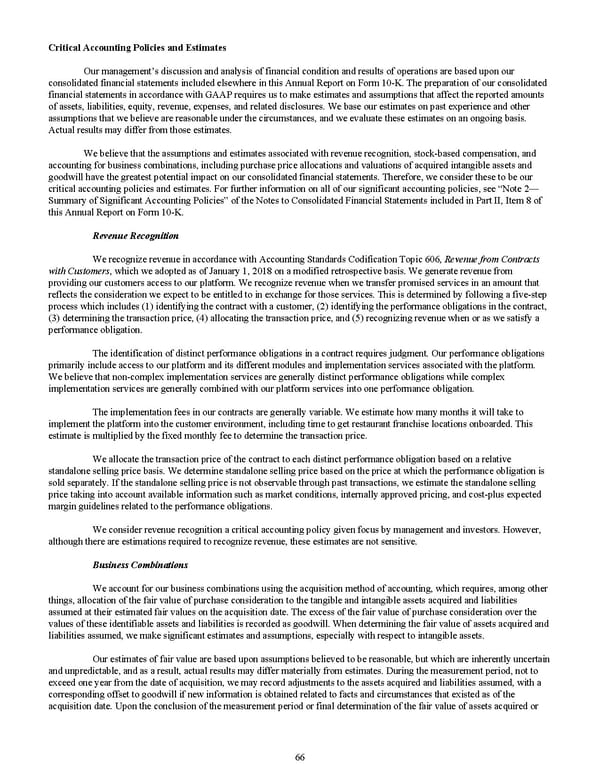Critical Accounting Policies and Estimates Our management’s discussion and analysis of financial condition and results of operations are based upon our c onsolidated financial statements included elsewhere in this Annual Report on Form 10-K. The preparation of our consolidated financial statements in accordance with GAAP requires us to make estimates and assumptions that affect the reported amounts of assets, liabilities, equity, revenue, expenses, and related disclosures. We base our estimates on past experience and other assumptions that we believe are reasonable under the circumstances, and we evaluate these estimates on an ongoing basis. Actual results may differ from those estimates. We believe that the assumptions and estimates associated with revenue recognition, stock-based compensation, and accounting for business combinations, including purchase price allocations and valuations of acquired intangible assets and goodwill have the greatest potential impact on our consolidated financial statements. Therefore, we consider these to be our critical accounting policies and estimates. For further information on all of our significant accounting policies, see “Note 2— Summary of Significant Accounting Policies” of the Notes to Consolidated Financial Statements included in Part II, Item 8 of this Annual Report on Form 10-K . Revenue Recognition We recognize revenue in accordance with Accounting Standards Codification Topic 606, Revenue from Contracts with Customers , which we adopted as of January 1, 2018 on a modified retrospective basis. We generate revenue from providing our customers access to our platform. We recognize revenue when we transfer promised services in an amount that reflects the consideration we expect to be entitled to in exchange for those services. This is determined by following a five-step process which includes (1) identifying the contract with a customer, (2) identifying the performance obligations in the contract, (3) determining the transaction price, (4) allocating the transaction price, and (5) recognizing revenue when or as we satisfy a performance obligation. The identification of distinct performance obligations in a contract requires judgment. Our performance obligations primarily include access to our platform and its different modules and implementation services associated with the platform. We believe that non-complex implementation services are generally distinct performance obligations while complex implementation services are generally combined with our platform services into one performance obligation. The implementation fees in our contracts are generally variable. We estimate how many months it will take to implement the platform into the customer environment, including time to get restaurant franchise locations onboarded. This estimate is multiplied by the fixed monthly fee to determine the transaction price. We allocate the transaction price of the contract to each distinct performance obligation based on a relative standalone selling price basis. We determine standalone selling price based on the price at which the performance obligation is sold separately. If the standalone selling price is not observable through past transactions, we estimate the standalone selling price taking into account available information such as market conditions, internally approved pricing, and cost-plus expected margin guidelines related to the performance obligations. We consider revenue recognition a critical accounting policy given focus by management and investors. However, although there are estimations required to recognize revenue, these estimates are not sensitive. Business Combinations We account for our business combinations using the acquisition method of accounting, which requires, among other things, allocation of the fair value of purchase consideration to the tangible and intangible assets acquired and liabilities assumed at their estimated fair values on the acquisition date. The excess of the fair value of purchase consideration over the values of these identifiable assets and liabilities is recorded as goodwill. When determining the fair value of assets acquired and liabilities assumed, we make significant estimates and assumptions, especially with respect to intangible assets. Our estimates of fair value are based upon assumptions believed to be reasonable, but which are inherently uncertain and unpredictable, and as a result, actual results may differ materially from estimates. During the measurement period, not to exceed one year from the date of acquisition, we may record adjustments to the assets acquired and liabilities assumed, with a corresponding offset to goodwill if new information is obtained related to facts and circumstances that existed as of the acquisition date. Upon the conclusion of the measurement period or final determination of the fair value of assets acquired or 66
 2022 10K Page 72 Page 74
2022 10K Page 72 Page 74